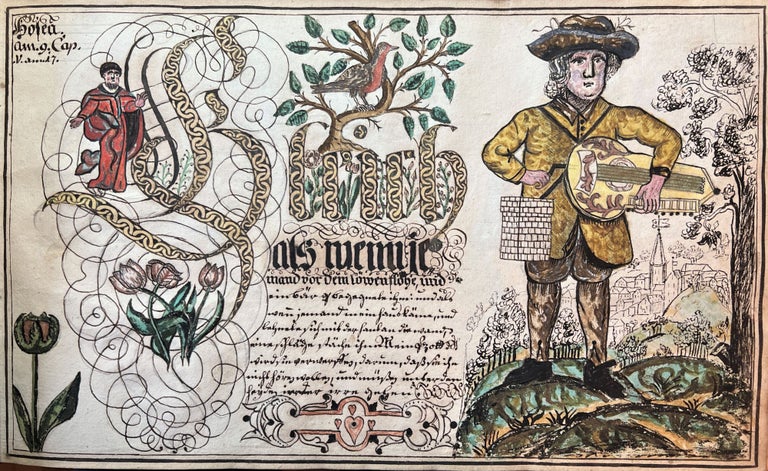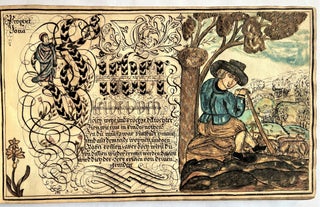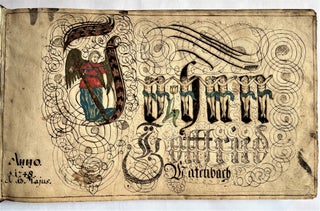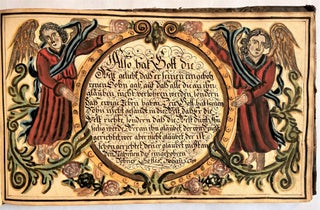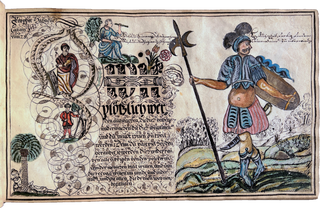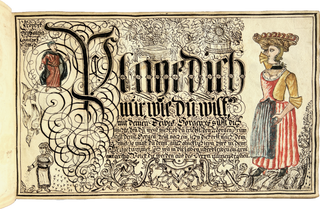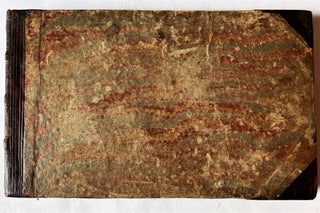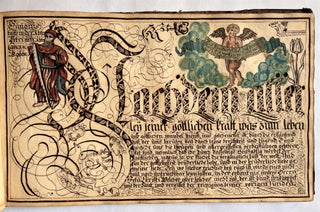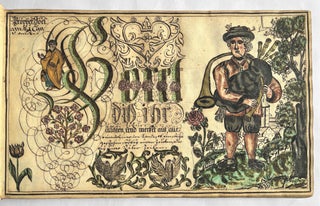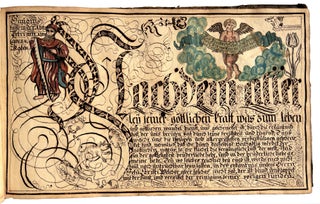Illustrated calligraphic sample book. [Germany or Austria], 1748.
Manuscript on paper, oblong folio (197 x 328 mm). [65] unnumbered leaves, written on rectos only, in pen-and-ink, pencil, watercolor and gouache within ink-ruled page borders, containing: a “title” leaf with the artist’s name and colored figures; 7 leaves of calligraphic alphabets; 49 leaves with flamboyantly ornamented calligraphic Biblical quotations or prayers in German, fulsomely illustrated, of which 36 leaves with the illustrations colored in watercolor or gouache (one figure in grisaille), and 13 uncolored or with only touches of color; 8 leaves with drawings and no text (some unfinished). Occasional corrections and insertions. Bound with 47 mostly blank leaves, 2 with pencil sketches, at the end a 9-page text in Dutch in a different 18th-century hand (datable to after 1772). Watermark: key within a crowned shield flanked by the letters H B.
Condition: first leaf slightly stained and frayed, some minor soiling, acidic ink causing some staining and an occasional small hole or tear along borders, frequent ink showthrough to versos (not affecting facing rectos), f. [64] detached. Bound in 18th-century half blind-ruled calf and marbled paper over boards, plain pastedown endpapers. ***
A lavishly illustrated “popular” calligraphic manuscript, whose creator Johann Gottfried Watenbach, otherwise unknown, possessed an exuberant visual imagination. He embellished his pious calligraphic quotations with both relevant figures — prophets, saints, and angels — and characters from everyday life: shepherds and peasant girls in bucolic landscapes, hunters, tradesmen and -women, a bagpiper, preachers and soldiers; and he also threw in ancient philosophers, a two-faced sibyl, exotic birds and animals, flowering plants and fruit baskets. Some small figures sit on swirls, others balance on unreadable ornate capitals, and a few are nearly hidden within interlocking clusters of ornaments. A dynamic propulsion pervades each page. Watenbach was probably a teenage student, showing off his calligraphic skills in this display album. While the calligraphy is respectable, the drawings are charmingly crude, and the overall effect is ludic, and enchanting.
Watenbach used the classic scripts taught in the German-speaking lands in the 18th century: the Latin script, Current or Kurrentschrift, and chancery or Kanzleischrift. He reveled in wildly ornate and figurative letters, used for the first line of each text (one or two very large words), which he decorated with intertwining or overlaid serpents, flowers, or chains, filling each letter with meticulously drawn geometric or repeated patterns. On fol. 42, the first line of the Epistle of James, 5:13, is overlaid by Psalm 23, in tiny script.
Biblical quotations were a common subject of German calligraphic model and exercise books, and Watenbach’s is no exception. Following the “title” leaf and a series of alphabets, the main part of the album consists of 45 leaves each with an elaborately presented quotation from the Lutheran Bible or a prayer. He identified the Biblical citations in the upper left corners (not always accurately: for example, the passage identified as Ezekiel 5:12 is actually from the Book of Lamentations [die Klagelieder Jeremiahs] 2:4, “He has bent his bow like an enemy...), choosing passages from the Old Testament: the apocryphal Wisdom of Solomon (Buch der Weisheit), chapter 8:8, Exodus (14:24-25), Psalms 37:5-6, the Prophets Isaiah, Jeremiah, Ezekiel (but see above), Daniel, Hosea, Joel, etc., and the New Testament: the Gospels, Epistles, and Acts of the Apostles; and various prayers. While he represented each Biblical figure or speaker in the upper left, the relationship to the text of the other figures illustrated, of which the largest usually appear in the right margins, is usually tenuous.
Contents:
Folio [1]: the scribe Watenbach’s name, “Johann” incorporating gouache and watercolor figures (an angel and 7 smaller human figures of indeterminate gender (souls?), wearing only loincloths, their arms raised, and a yellow tulip).
Ff. [2-8]: 7 leaves of alphabets. Ff. 2-3 with full alphabets, their scripts identified as Current, “small and large” (i.e., minuscule and majuscule) Latin; French, chancery (Cantzley) script, and Greek (a double-column list of the Greek letters and their names); f. 4 with a fine full-page chancery alphabet of capitals, originally highlighted in a yellowish dye apparently imitating gold (mostly abraded); ff. 5-8 with very large ornamented capitals with intricate flourishes and decorative infill in pen-and-ink or color, a few incorporating flowers, one, the N on f. 6 containing the name Johann Gottfried Watenbach(?) and the date Anno 1748.
F. [9]: dedication to Christ, in German and Latin (”Alphabetum Germanicum et Latinum”) within colored cartouche border with a pair of angels holding a torch and a flame.
Ff. [10-54]: Biblical citations, the first two or three lines of each in ornate colored calligraphic lettering, the rest in Kantzlei or Currentschrift, the text flanked by a wide variety of illustrations, some or all of the figures colored in gouache and watercolor on ff. 10-28, 33, 36-47, those on ff. 29-32, 34-35 and 48-54 with only touches of red coloring or uncolored. Grisaille portrait of the Churfürst (Prince Elector) of Cologne on f. 39. F. 10 with allegorical female figures of justice and wisdom holding a shield bearing the scribe-artist’s initials W I G, at lower left his name and the date 3 September 1748; his initials or monogram appear as well on ff. 12, 15 (with the year), 20, 35 and 50.
Ff. [55-58] each with two pencil and/or ink sketches or portraits within roundel borders, fol. 55 with 2 lines of text, else no text, fol. 57 depicting Luther and his wife Katharina von Bora, fol. 58 with an unfinished partly colored portrait of a woman in central roundel flanked by putti.
Ff. [59-61] each with a biblical citation in Kantzleischrift within a large circular colored roundel and hand-colored floral and figurative border, incorporating angels and other figures; fol. 62 unfinished, with the colored border only and no text; ff. 63-64 pencil sketches of borders.
Fol. 65: sketch of scales of justice, followed by 47 mainly blank leaves, the first two with border rules, the 31st and 32nd with two unfinished pencil drawings, one with a sphere and a soldier fencing, the sphere labeled “Mundus / Die Welt,” the second showing a bearded man in classical garb walking holding a carafe, with an unlettered banner sketched in the background; at end a 9-page manuscript in Dutch in a flowing cursive hand, written after 1772 (containing 2 pieces, with headings “Een Beschreÿving van Melchisedeks Koning van Salem” and “Geschiedenis van den Koning van Sweden Geworden Suvaraÿn den 19 August 1772”). Item #4200
No longer available

